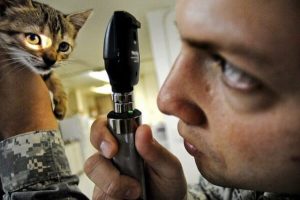A thousand years ago, Ancient Egyptians domesticated cats as pest exterminators. The practice may have persisted until modern times (particularly in some Middle Eastern countries), but the general attitude of pet owners in contemporary era have gradually shifted from treating cats as outdoor pest killers to indoor fur babies (and for the right reasons).
The People for Ethical Treatment of Animals (PETA) and American Humane both advocated for keeping cats indoors – with the latter providing a more detailed emphasis on health risks associated with pet cats wandering outdoors. Curiously, a research project in the United Kingdom conducted by the Royal Veterinary College for the BBC Horizon program revealed a surprising tendency of pampered (even overfed) pet cats to roam outside the house to hunt for live prey.
The reality of the indoor cat’s strong basic instincts makes the efforts of pet owners challenging and all the more meaningful. The least dangerous yet most prevalent effect of outdoor exposure is intestinal parasite infection. Cats that are plagued by worms can be troublesome, not to mention extremely messy.
Understanding Intestinal Parasites

According to Pets Web MD, cats rarely display outward symptoms of intestinal parasites. Oftentimes, on top of it being seriously dangerous to the cat’s health, intestinal parasite infection can go undetected. The usual symptoms that warrant a clearer diagnosis from the vet clinic include vomiting, lethargy, diarrhea, distended stomach, and the lack of appetite.
There are three common ways feline intestinal parasites are transmitted. Unhealthy mother cats may transmit worms when nursing vulnerable kittens. Cats ingesting live (unsanitary) prey such as birds and rodents may acquire worms. Lastly, intestinal parasites may also be obtained by coming into contact with surroundings infected with worm-ridden feline feces.
There are three common types of intestinal worms infecting cats. Ringworms are noodle-like parasites often affect kittens after feeding on the milk of an infected mother. Tapeworms ordinarily infect adult cats after an outdoor hunting spree ingesting infected rodents. Hookworms are often acquired through skin contact with flea-infested or larvae-spawned soil (usually during their territorial mating imprint).
Breaking Down Deworming Cost
In understanding the total cost to deworm a cat, the pet parent must break down expenses in line with the step-by-step process of purging the infection. These particular phases are arranged ‘chronologically’ as diagnosis, medication, and decontamination.
Phase 1: Diagnosis
The initial cat deworming price is intended for a visit to the vet clinic. According to the website called Cat Cat Cat, the price range for an initial check-up is anywhere between $31 and $131. Take note: health checks are non-negotiable considering that precise diagnosis helps avoid compounding the problem of ineffective and/or dangerous medications.
It is possible to cover these medical expenses if the owner has already acquired insurance plans. The website called Reviews.com highlighted the four leading providers of cat health care insurance in the United States in the year 2017. These are the following companies ranked accordingly:
Pets Best (No. 1)
Additional details: Flexible and comprehensive (cat) lifetime plan. Complete $10,000 coverage for a variety of common cat illnesses. Insurance also covers congenital and hereditary conditions.
VPI (No. 2)
Additional details: Comprehensive health care plan. Cats must be at least aged 10 in order to be an eligible member.
Pet First Pet Insurance (No. 3)
Additional details: Lifetime (per annual limits) and Standard (per incident limits) plans. It only has a non-specific pet healthcare coverage.
Petplan USA (No. 4)
Additional details: Features reimbursement of stolen or lost cat. Arguably the country’s best place for cat health care discounts.
Phase 2: Medication
Veterinarians will prescribe a deworming treatment after their diagnostic inspection. For this phase, the cost to deworm a cat is somewhere around $3 to $18. Take note: owners must abide by the physician’s prescription. Although it is possible to research about cheaper brands of similar medicine, one has to account the possible adverse effects of drugs that were not specifically prescribed by the vet.
Another possible addition to the overall cat deworming price is rehydration. There are certain cases of worm infections that have progressed to such an extent that it rendered the poor felines desiccated. In this case, a vet will administer fluids intravenously. The projected cost is anywhere between $15 and $48.
Decontamination: Killing Worms For Good!
When it comes to the overall cost to deworm a cat, one must look beyond spending on medication alone. The last phase of eradicating the plague is purging the potential source nearby, especially the residue of contagion inside. Each of these following procedures entails its own additional spending:
Waste Disposal
The indoor litter used by cats once infected by intestinal worms has already become a breeding ground for another cycle of infection. After removing the clumps of feces and urine, one must empty the litter box of the remaining litter (sand or pellets) and clean it thoroughly. It is important to add bleach while refilling the litter box. One is looking at a projected cost of $5 for a bottle of bleach and $10 for the litter.
Disinfection

Another final addition to the cat deworming price is the projected cost of decontaminating the fur baby’s living quarters by buying dewormer for cats. Fleas are considered to be an infamous vector of parasitical worms. For this reason, removing feline lice is practically ‘hitting two birds with one stone.’ When it comes to disinfecting one’s home from potential flea plague, homeowners have three options to choose from.
The easy-to-use flea insecticide usually costs anywhere around $5 to $50. Toxic flea bombs can guarantee complete eradication of fleas indoors at the average cost ranging between $10 and $150, while flea sprays spewed at the garden only cost an average of $10 to $30. Hiring a professional exterminator to deal with persistent flea infestation may cost around $150 to $300, along with a minimum of a 6-month service contract.
Apart from fleas, residue germs left behind by the once infected cat may still have a chance of thriving. According to International Cat Care, neutralizing germs with ordinary household products may not be completely safe for indoor cats. A chemical compound called benzalkonium chloride induces a number of mild toxic reactions in the feline physiology. Fortunately, special cleaning products such as Johnson’s Clean N Safe disinfectant spray (sold online at roughly $4.38) do not contain irritating substances for cats.
